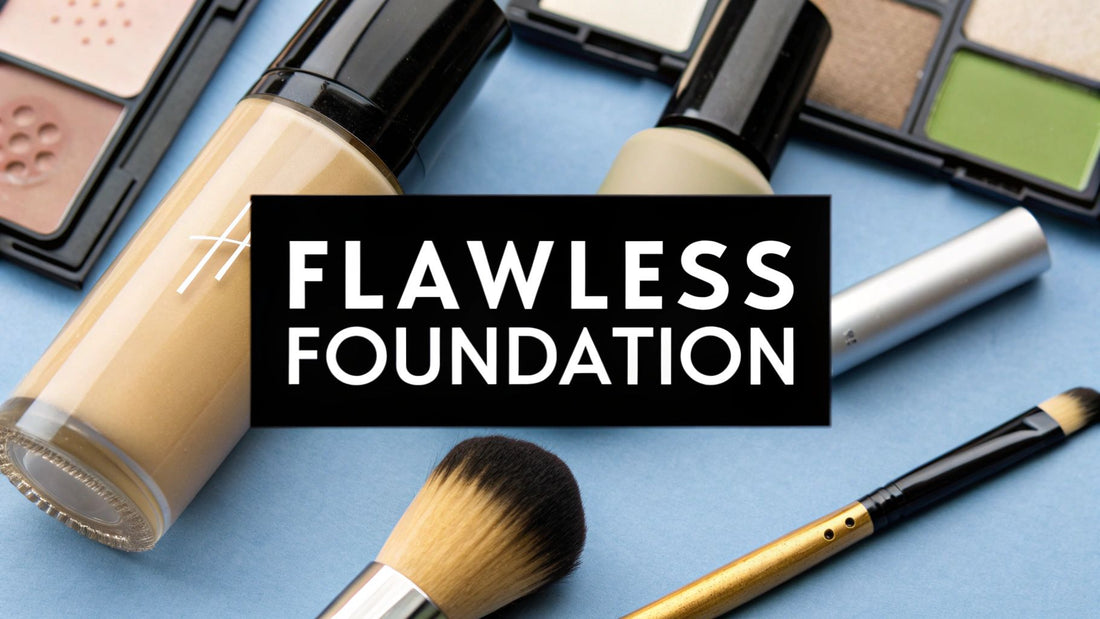Let's be honest, the hunt for the perfect foundation can feel like a lifelong quest, especially when you're navigating the changes that come with mature skin. For so many of us women over 50 in Canada, it’s a frustrating cycle of trial and error. The real secret isn't just about picking a shade that looks good in the bottle; it’s about mastering skin color matching foundation by truly understanding your skin's unique character.
It's about finding that one-in-a-million shade that melts into your skin, looking completely natural.
Finally Find Your Flawless Foundation Match
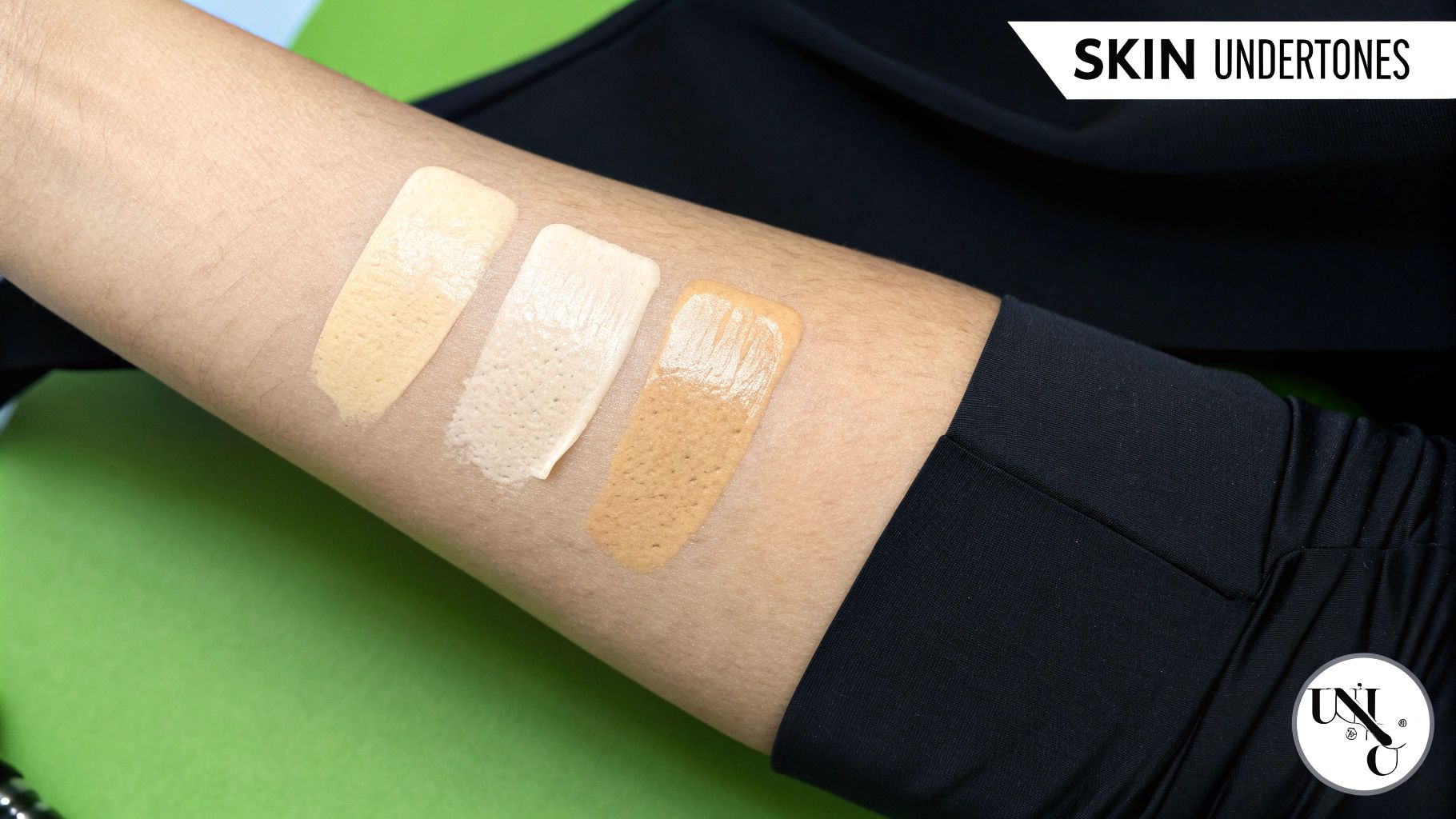
We’ve all been there. You find a foundation that seems perfect under the bright, unforgiving lights of the store, only to step outside and see it’s completely wrong—too orange, too pink, or worse, a bit ashy. This is a common story, and it only gets trickier as our skin evolves over the years.
This guide is designed to help you, as a woman over 50, finally put an end to the guessing game. We're going to skip the generic tips and get straight to the practical, real-world techniques you need for a seamless, beautiful match. The aim? To give you the know-how and confidence to walk into any Shoppers Drug Mart or Sephora Canada and pick a winner.
It's More Than Just a Shade Number
A truly great foundation does so much more than just match the surface of your skin. It has to work with your complexion, especially when it comes to mature skin. This is about finding a formula that understands what your skin needs right now.
Think of your ideal foundation as a true multitasker. It should:
- Gently even out your skin tone, never hiding your natural beauty behind a mask.
- Plump and hydrate your skin, gliding over fine lines instead of settling into them.
- Work in harmony with your undertone to create a finish that looks like you were born with it.
It's no wonder the beauty world is pouring resources into this. The global market for foundation shade finders was valued at around USD 1.2 billion and is climbing fast. That number just proves how many of us are searching for personalized solutions that actually work.
The goal is simple: find a foundation that makes you feel incredible in your own skin. It should look just like you, but on your very best day—smooth, radiant, and utterly natural.
Getting there takes a little bit of prep work. Before you start swatching, the single most important thing you can do is figure out your skin's undertone. Honestly, this one piece of information is the key that unlocks everything else.
If you want a bit more background on the whole selection process, our guide on color matching for foundation is a great place to start. It'll give you a solid foundation (pun intended!) for what we’re about to cover.
How to Identify Your Skin's True Undertone
Before we even start looking at foundation shades, we need to talk about the single most important factor in finding a perfect match: your undertone. This is the subtle color that lies just beneath your skin's surface. Your surface tone might get a little darker after a summer long weekend at the cottage, but your undertone never changes. Getting this right is the difference between a foundation that looks flawless and one that just looks... off.
Forget all the confusing beauty counter jargon. I’m going to walk you through a few simple, practical ways to figure this out right now, from the comfort of your own home. Trust me, this one piece of knowledge will completely change the way you shop for makeup forever.
Simple At-Home Tests for Undertone
One of the oldest and most reliable tricks in the book is the vein test. Take a look at the inside of your wrist in good, natural daylight. What's the predominant color you see?
- If your veins look mostly blue or purple, you likely have a cool undertone. This means your skin has subtle hints of pink, red, or blue.
- If your veins appear more green or olive, you almost certainly have a warm undertone. Your skin leans toward yellow, golden, or peachy hues.
- Seeing a mix of both? If it’s hard to tell whether they’re blue or green, you’re probably looking at a neutral undertone—a beautiful balance of warm and cool.
Another brilliant clue is how different metals look against your skin. I've always known that silver jewelry makes my skin look brighter and more vibrant, which is a classic sign of a cool undertone. If you find that gold pieces give you a beautiful, healthy glow, you're likely on the warm side of the spectrum. And if you're lucky enough to pull off both silver and gold with ease? You're probably neutral.
The chart below breaks down these easy tests into a simple, at-a-glance guide.
Undertone Identification Cheat Sheet
Use this quick guide to determine your skin's undertone with simple at-home methods.
| Test Method | Warm Undertone Clues | Cool Undertone Clues | Neutral Undertone Clues |
|---|---|---|---|
| The Vein Test | Veins on the wrist appear greenish or olive. | Veins on the wrist appear blue or purplish. | It's difficult to tell; you see a mix of green and blue. |
| The Jewelry Test | Gold jewelry flatters your skin and makes it glow. | Silver, platinum, or rose gold jewelry brightens your complexion. | Both gold and silver jewelry look great on you. |
| The Sun Test | You tend to tan easily and rarely burn. | You tend to burn easily and have a hard time tanning. | You might burn at first, but it eventually turns into a tan. |
| The White Fabric Test | Off-white or cream fabrics look better on you than stark white. | Crisp, pure white fabric complements your skin best. | Both pure white and off-white are equally flattering. |
Think of these as clues, not hard-and-fast rules. Most people find that one or two of these tests give them that "aha!" moment.
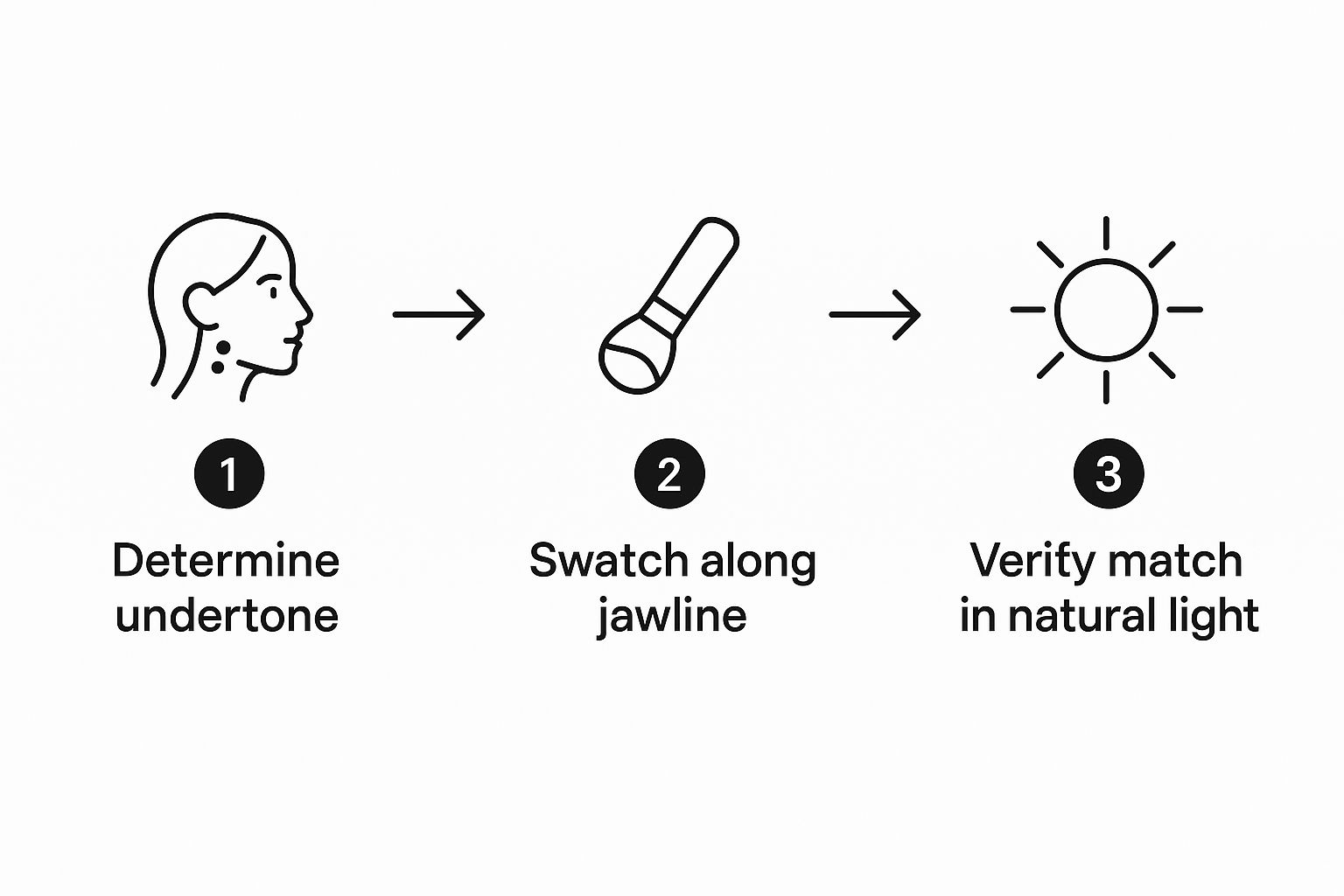
As you can see, figuring out your undertone really is the foundational (pun intended!) step that sets you up for success.
Why Your Undertone Is Such a Game-Changer
Understanding your undertone helps you immediately filter out dozens of shades that were never going to work for you anyway. Have you ever tried a foundation that looked perfect in the bottle, only to see it turn slightly orange or ashy an hour after you applied it? That’s almost always an undertone mismatch.
Knowing your undertone is like having a secret roadmap to the right foundation aisle. It prevents you from choosing a shade that will fight against your natural coloring, ensuring the final result is seamless.
This knowledge empowers you to look for foundations with the right base color. Many brands available in Canada make it easy by labeling their shades with a 'W' for warm, a 'C' for cool, or an 'N' for neutral. If you want to explore this topic even further, our complete guide on color matching for foundation offers even more tips.
Mastering this one concept truly eliminates the guesswork and gets you so much closer to that flawless, second-skin finish we're all looking for.
Choosing the Right Foundation Formula for Your Skin
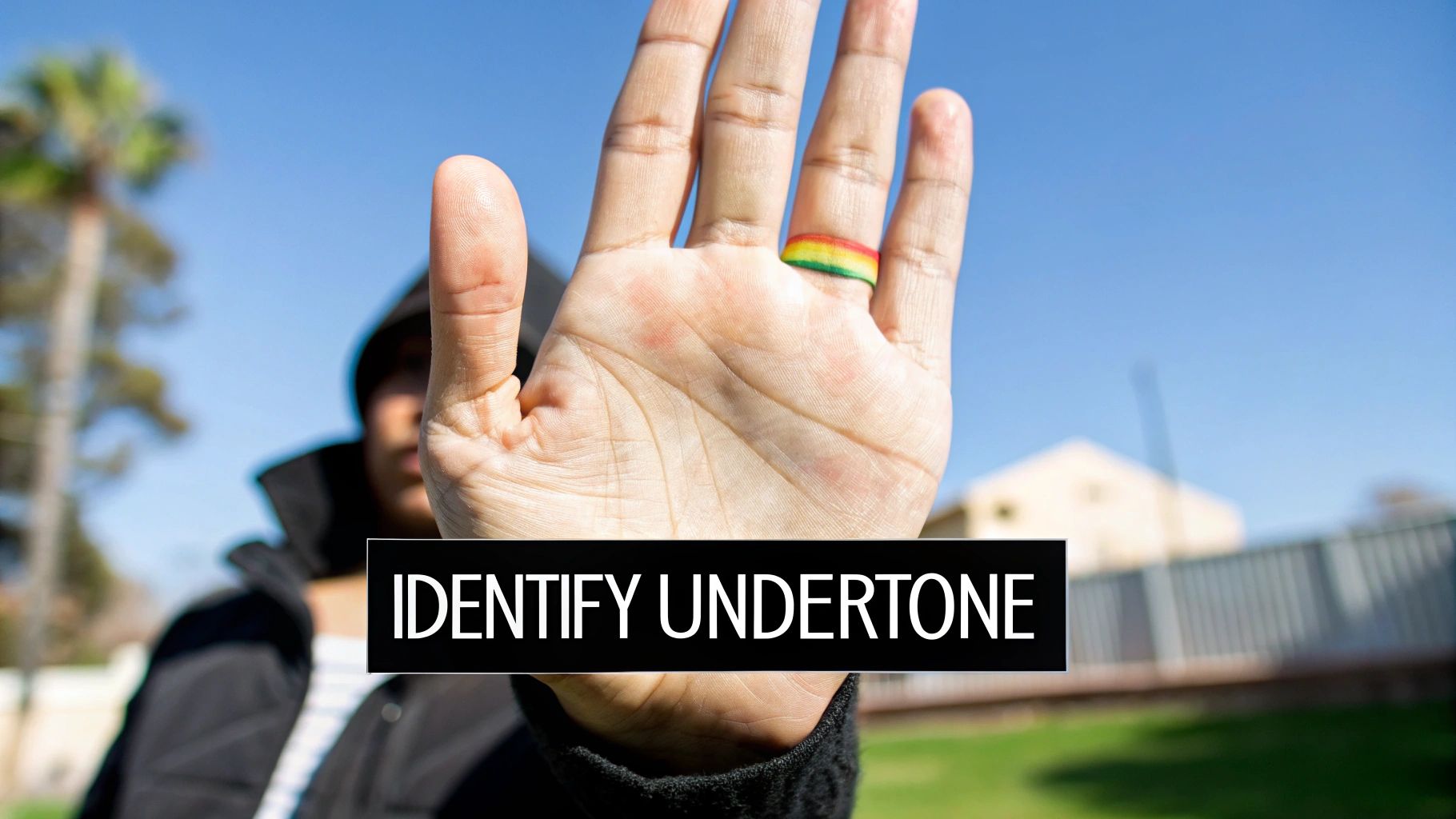
Finding your perfect foundation match is about so much more than just the shade. The real magic, especially for those of us with mature skin, lies in the formula. As we age, our skin tends to get a bit drier and loses some of that youthful elasticity. The wrong foundation can be unforgiving, settling into fine lines and making us look older, while the right one can create a smooth, luminous complexion that looks and feels incredible.
This is why I always tell my clients to think of their foundation as the last step in their skincare routine. This is where hydrating liquid and serum foundations really get to shine. They’re often packed with powerhouse ingredients that deliver a gorgeous, dewy glow.
Embrace the Glow: Why Liquids and Serums Are Your Best Friends
There’s a good reason liquid foundations are a staple in almost every makeup bag. They give you buildable coverage and a finish that looks like real skin, only better. The market for liquid foundation was valued at a staggering USD 8.4 billion, which just goes to show how much we all love this versatile formula. You can read up on the latest market trends at Global Growth Insights if you're curious.
But for mature skin, we need to be even more selective. Don't just grab any liquid foundation; look for specific descriptions on the bottle that promise great things for your skin.
Keep an eye out for formulas described as:
- Luminous or Radiant: These are my absolute favorites. They contain incredibly fine, light-reflecting particles that create a soft-focus effect and give your skin a beautiful, youthful glow.
- Hydrating: These are often formulated with ingredients like hyaluronic acid, which is a moisture magnet. It helps to plump up the skin from within, softening the appearance of lines before you even blend.
- Serum-Infused: Think of these as the overachievers of the foundation world. They’re super lightweight and combine the color coverage of a foundation with the potent, skin-loving benefits of a high-quality serum.
The beauty of these modern formulas is how they glide over the skin's texture instead of getting stuck in it. They feel comfortable all day long and move with your face, not against it.
A great foundation for mature skin shouldn't feel like a heavy mask. It should feel like a luxurious treatment that enhances your natural beauty, not hides it.
The Formulas You Should Probably Skip
Knowing what to look for is half the battle; knowing what to steer clear of is the other half. Some formulas just aren't kind to mature skin and won’t give you that flattering finish you deserve.
Heavy, full-coverage matte foundations are usually the biggest offenders. They promise to hide everything, but their thick, often dry texture can easily look cakey and has a nasty habit of emphasizing every single fine line or dry spot. Powder foundations can also be a challenge, as many formulas tend to absorb moisture, which is the last thing you want on already dry skin. It can leave your complexion looking dull and flat.
For some of my top product recommendations and more in-depth advice, you’ll definitely want to check out our complete guide to the best foundation for aging skin. It’s packed with specific tips and picks that I trust.
At the end of the day, your goal is to find a foundation that works with your skin, adding back the moisture and luminosity that time can take away. When you prioritize hydration and a radiant finish, your foundation becomes your best ally for a flawless, beautiful complexion every single time.
Getting Your Foundation Shade Just Right: How to Test and Swatch Like a Pro
Let's put an end to one of the biggest makeup mistakes we all make—swatching foundation on the back of our hand. It feels right, doesn't it? But the skin on our hands is a totally different world from the skin on our face in both color and texture. This one little habit is the main culprit behind that frustrating moment when you get home and realize your new foundation is completely wrong.
There's a much better way to do it, a simple technique that makeup artists use to guarantee a perfect, seamless match. It’s the secret to finding a skin color matching foundation that truly looks like your skin, but better.
Where and How to Find Your Perfect Match
The best spot to test your foundation isn't your wrist or your hand—it's your jawline. Think of this area as the bridge that connects your face to your neck. A truly great foundation match has to blend flawlessly with both. If it doesn't, you end up with that dreaded "floating head" look where your face is one color and your neck is another.
Here’s the simple method that will change your makeup game for good:
- Pick three shades you think are the closest contenders. Don't just grab one!
- Draw small vertical stripes of each shade right on your jawline, side-by-side.
- Lightly blend the stripes downward just a little, onto the very top of your neck.
The right shade will almost seem to vanish right into your skin. It won’t look like a stripe of makeup at all. It shouldn't be too light, too dark, or have the wrong undertone. It should just... disappear. Using the right tool can make a world of difference here; a good synthetic foundation brush is brilliant for buffing foundation into the skin for that flawless, airbrushed look.
Your goal is to find the shade that creates an invisible transition from face to neck. If you have to work hard to blend it in, it's not your color.
The Two Most Important Final Checks
Okay, so you’ve got your stripes. Don't head to the checkout just yet! Department store lighting is notoriously tricky and can make even a bad match look passable. You need to see how it looks in the real world.
Find a window or, even better, step outside for a moment into natural daylight. This is the ultimate truth-teller. It will instantly show you if a shade is too pink, too yellow, or just not the right depth for your skin.
Finally, you need to give it a little time. Many foundations oxidize, which is a fancy way of saying they can get a bit darker as they dry and mix with your skin's natural oils. Wait at least 15-20 minutes and then take another look at your swatches. That shade you thought was perfect might now be a hair too dark. A little patience in the store will save you so much frustration later. After all, with the foundation finder market in North America valued at around USD 400 million, brands are constantly innovating to deliver that perfect match—it’s worth taking a moment to make sure you’ve found it. You can see more about the growing foundation shade finder market on dataintelo.com.
Foundation Shopping Tips for the Canadian Market
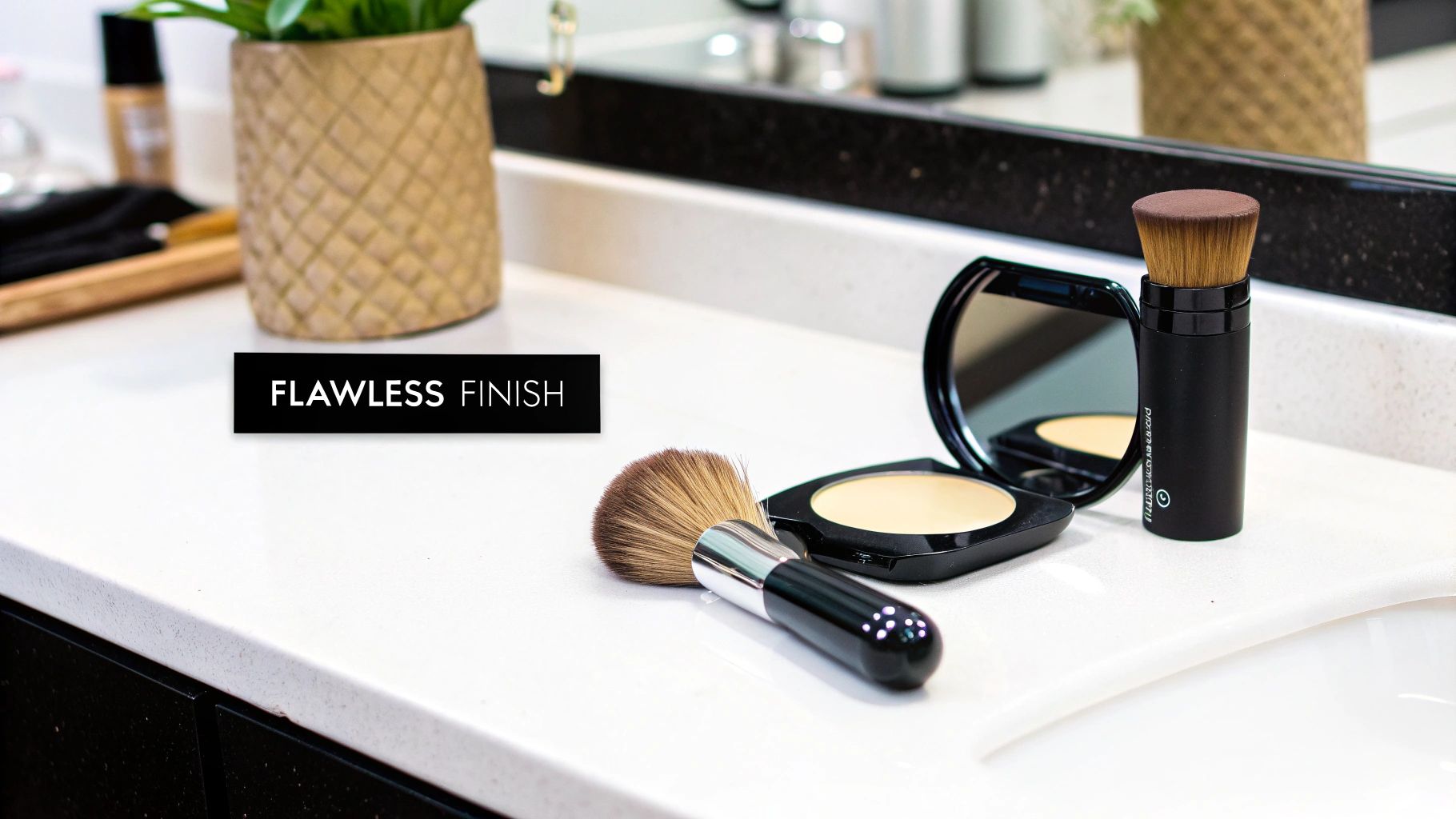
Navigating the beauty aisles in Canada can feel a little different, whether you’re browsing a flagship store in downtown Toronto or ordering online from rural Alberta. But finding your perfect foundation here is absolutely achievable with a bit of local know-how. It’s all about using the resources right at your fingertips.
For many of us, getting a proper in-person match is the best place to start. I’ve always found the Beauty Boutiques at Shoppers Drug Mart or the makeup experts at Sephora Canada to be fantastic resources. Their lighting is set up specifically for makeup application, and the advisors are genuinely skilled at helping with skin color matching foundation.
Don't be afraid to ask for their expertise, and my number one rule? Never, ever leave without a few samples. Testing a shade at home, in your own lighting and in natural daylight by a window, is the only way to be 100% certain before you commit to buying a full bottle.
Smart Online Shopping in Canada
Let’s be honest, sometimes shopping online is just plain easier. Thankfully, many brands have made it incredibly simple to shop from home with Canadian-friendly sites and virtual tools. Brands that are staples here, like MAC and Estée Lauder, have excellent virtual try-on features on their Canadian websites that are worth checking out.
These tools use your phone or computer camera to give you a surprisingly good preview of how a shade will look on your skin. While it's not a perfect substitute for swatching it on your jawline, it’s a brilliant way to narrow down an overwhelming list of options to just two or three solid contenders. This takes a lot of the guesswork out of ordering online.
To get the most out of these virtual tools, here are a few tips from my own experience:
- Find good light: Always sit facing a window. Natural, even lighting is key.
- Start with a clean slate: Make sure your face is completely bare for the truest color reading.
- Check all the angles: Gently turn your head from side to side to see how the foundation shade looks along your jawline and cheeks.
Finding Inclusive Shade Ranges
The Canadian market has really embraced inclusivity, and we have access to many brands that offer wonderfully extensive shade ranges. Fenty Beauty, which you can find at Sephora, completely changed the game with its spectrum of shades. Likewise, brands like NARS and the Canadian-born-and-bred MAC Cosmetics have been longtime champions of providing options for every skin tone and undertone.
By focusing on brands known for their diverse shade selections, you drastically increase your chances of finding that seamless match that just melts into your skin.
Remember, finding the right formula is just as crucial as the shade, especially for mature skin. For a deeper dive into this, our guide on the best foundation for mature skin has some specific advice on the ingredients and finishes that work best. By combining in-store expertise with savvy online tools, you’ll be well on your way to finding your holy grail foundation, no matter where you are in Canada.
Answering Your Touhest Foundation Matching Questions
Even after you've nailed down the basics, some nagging questions can still make finding the perfect foundation feel like a bit of a puzzle. Trust me, you're not the only one. Let's tackle some of the most common challenges I hear about, especially when it comes to mature skin.
Getting these little details right is what separates a pretty good foundation match from one that looks truly incredible and seamless.
How Do I Keep My Foundation Shade Looking Right Through the Seasons?
Ah, the classic Canadian conundrum. The skin tone you have in the summer sun is rarely the same one you see in the mirror mid-winter. But you definitely don't need a whole new bottle of foundation for every season. There are much smarter, more practical ways to handle this.
A tried-and-true method is to simply own two core shades: one that matches you at your palest in winter and another that matches your deepest summer tan. For those in-between months in spring and fall, you can become your own custom blender, mixing a little of each on the back of your hand until you get the exact colour you need for that day. It’s surprisingly easy.
Another brilliant, and often more budget-friendly, solution is to invest in foundation-adjusting drops. These are little bottles of pure pigment—some to lighten, some to darken—that you mix into your go-to foundation. A single drop can shift the colour just enough, giving you total control all year long without cluttering your makeup bag.
Should I Match My Foundation to My Face or My Neck?
This one is a golden rule, and it's non-negotiable if you want to look natural: always match your foundation to your neck and chest. It's incredibly common for our faces to be a bit lighter than our bodies, especially if we've been diligent with sunscreen over the years (good for you!). If you only match the skin on your face, you'll end up with that dreaded "floating head" look where your face looks disconnected from the rest of your body.
The whole point is to create a seamless, believable look. Swatch potential shades along your jawline and look for the one that practically disappears into your neck. When you apply it, always remember to blend it down past your jaw, creating that beautiful, harmonious transition.
What Is Foundation Oxidation and How Can I Stop It?
Ever put on foundation and think it’s the perfect match, only to glance in the mirror an hour later and see it's turned darker or even a little orange? That frustrating phenomenon is called oxidation. It's a chemical reaction that happens when the pigments in the makeup mix with the air and the oils on your skin.
Thankfully, the fix is pretty straightforward. You just need to create a barrier between your skin’s natural oils and your foundation.
Using a good primer before your foundation is your absolute best defense against oxidation. It creates a smooth canvas and stops your skin's oils from messing with the foundation's formula, which helps the color stay true all day long.
As a rule of thumb, whenever you're testing a new foundation, swipe it on your jawline and give it at least 20 minutes before you decide. This gives it enough time to settle and show you its true, final color.
Can I Really Use Powder Foundation on Dry, Mature Skin?
You absolutely can! The trick is to forget everything you might remember about those old, heavy, chalky powders. Today's formulas are a different beast entirely. Finely milled mineral powders can look absolutely beautiful on mature skin, giving a soft, airbrushed finish without settling into lines.
The secret is all in the prep work. Your skin needs to be thoroughly hydrated and moisturized before you even think about powder.
- Start with your richest moisturizer.
- Follow up with a hydrating primer. This is key, as it will smooth your skin’s texture and stop the powder from grabbing onto any dry spots.
- Look for powders described as "satin," "luminous," or "radiant." Stay away from anything labeled "matte," as it can flatten the look of your skin. These formulas will impart a subtle, healthy-looking glow.
Finding your perfect foundation is a journey of confidence and self-expression. At PriPedi, we create makeup and skincare designed to make women over 50 feel beautiful and radiant in their own skin. Discover formulas that nourish and enhance your natural beauty by exploring our collection.

